
The M16 rifle is a family of military rifles adapted from the ArmaLite AR-15 rifle for the United States military. The original M16 rifle was a 5.56×45mm automatic rifle with a 20-round magazine.

The Colt AR-15 is a lightweight, magazine-fed, gas-operated semi-automatic rifle. It is a semi-automatic version of the M16 rifle sold for the civilian and law enforcement markets in the United States. The AR in AR-15 stands for ArmaLite rifle, after the company that developed it in the 1950s. Colt's Manufacturing Company currently owns the AR-15 trademark, which is used exclusively for its line of semi-automatic AR-15 rifles.

A flechette is a pointed, fin-stabilized steel projectile. The name comes from French fléchette, meaning "little arrow" or "dart", and sometimes retains the acute accent in English: fléchette. They have been used as ballistic weapons since World War I. Delivery systems and methods of launching flechettes vary, from a single shot, to thousands in a single explosive round. The use of flechettes as antipersonnel weapons has been controversial.

The M1 carbine is a lightweight semi-automatic carbine that was issued to the U.S. military during World War II, the Korean War, and the Vietnam War. The M1 carbine was produced in several variants and was widely used by paramilitary and police forces around the world after World War II.
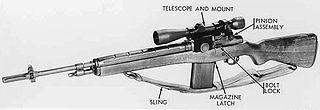
The M21 Sniper Weapon System (SWS) in the US Army is a national match grade M14 rifle, selected for accuracy, and renamed the M21 rifle. The M21 uses a commercially procured 3–9× variable power telescopic sight, modified for use with the sniper rifle. It is chambered for the 7.62×51mm NATO cartridge.

The M1903 Springfield, officially the U. S. Rifle, Caliber .30, M1903, is an American five-round magazine-fed, bolt-action service repeating rifle, used primarily during the first half of the 20th century.
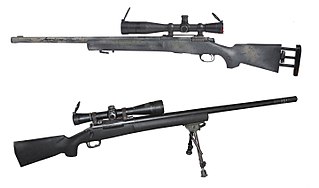
A sniper rifle is a high-precision, long-range rifle. Requirements include high accuracy, reliability, and mobility, concealment, and optics, for anti-personnel, anti-materiel and surveillance uses by military snipers. The modern sniper rifle is a portable shoulder-fired rifle with either a bolt action or semi-automatic action, fitted with a telescopic sight for extreme accuracy and chambered for a high-ballistic performance centerfire cartridge.
The Heckler & Koch PSG1 is a semi-automatic sniper rifle designed and produced by the German company Heckler & Koch.
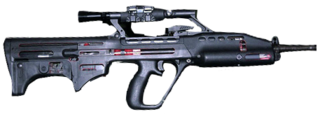
The SAR 21 is a bullpup assault rifle designed and manufactured in Singapore, chambered for the 5.56x45mm cartridge. First revealed and subsequently adopted by the Singapore Armed Forces (SAF) as its standard service weapon in 1999, it was designed and developed over a four-year period to replace the locally license-built M16S1 by the Ministry of Defence (MINDEF), Singapore Army and the former Chartered Industries of Singapore (CIS), presently ST Engineering Land Systems.
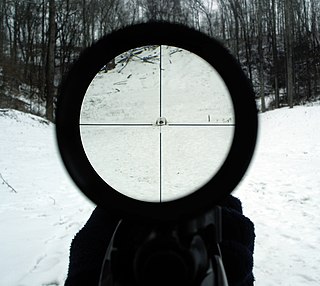
A telescopic sight, commonly called a scope informally, is an optical sighting device based on a refracting telescope. It is equipped with some form of a referencing pattern – known as a reticle – mounted in a focally appropriate position in its optical system to provide an accurate point of aim. Telescopic sights are used with all types of systems that require magnification in addition to reliable visual aiming, as opposed to non-magnifying iron sights, reflector (reflex) sights, holographic sights or laser sights, and are most commonly found on long-barrel firearms, particularly rifles, usually via a scope mount. Similar devices are also found on other platforms such as artillery, tanks and even aircraft. The optical components may be combined with optoelectronics to add night vision or smart device features.

The FN F2000 is a 5.56×45mm NATO bullpup rifle, designed by FN Herstal in Belgium. Its compact bullpup design includes a telescopic sight, a non-adjustable fixed notch and front blade secondary sight. The weapon has fully ambidextrous controls, allowed by a unique ejection system, ejecting spent cartridge casings forward and to the right side of the weapon, through a tube running above the barrel. The F2000 made its debut in March 2001 at the IDEX defence exhibition held in Abu Dhabi, in the United Arab Emirates.

A milliradian is an SI derived unit for angular measurement which is defined as a thousandth of a radian (0.001 radian). Milliradians are used in adjustment of firearm sights by adjusting the angle of the sight compared to the barrel. Milliradians are also used for comparing shot groupings, or to compare the difficulty of hitting different sized shooting targets at different distances. When using a scope with both mrad adjustment and a reticle with mrad markings, the shooter can use the reticle as a ruler to count the number of mrads a shot was off-target, which directly translates to the sight adjustment needed to hit the target with a follow-up shot. Optics with mrad markings in the reticle can also be used to make a range estimation of a known size target, or vice versa, to determine a target size if the distance is known, a practice called "milling".
The L42A1 is a bolt-action sniper rifle chambered for the 7.62×51mm NATO cartridge. Used in the past by the British Army, Royal Marines and Royal Air Force RAF Regiment, the L42A1 entered service in 1970. It was replaced by the Accuracy International AW in 1985.

Vidhwansak is an Indian multi-caliber anti-materiel rifle (AMR) or large-caliber sniper rifle manufactured by Ordnance Factory Tiruchirappalli. It can be used in the anti-materiel role for destroying enemy bunkers, lightly armoured vehicles, radar systems, communication equipment, parked aircraft, fuel storage facilities, etc. It is also effective in long-range sniping, counter sniping, and ordnance disposal roles.

The FR F1 is a French sniper rifle manufactured by the Manufacture d'armes de Saint-Étienne (MAS); one of several government-owned arms factories in France. The FR F1 was France's first purpose-built precision rifle for sharpshooters. Introduced in 1966, the rifle was in use with the French Armed Forces until 1989 when it was replaced by the FR F2.

The APR is a bolt-action sniper rifle designed by the Thun-based Brügger & Thomet in 2003 as an evolution of the French PGM Précision.
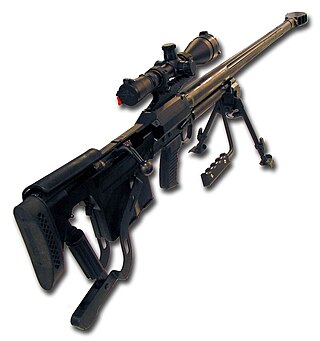
The WKW Tor (Thorium) or Wilk (Wolf) is a modern anti-materiel and/or sniper rifle produced in Poland by the Zakłady Mechaniczne Tarnów factory. The nickname "WKW Tor" stands for Wielkokalibrowy Karabin Wyborowy or Large Caliber Sniper Rifle. Its military designation in the Polish army is known as the Tor. This rifle was developed between 2000 and 2004 and the first selected units in the Polish army apparently received Wilk/Tor rifles in around 2005 onwards.
The PSL is a Romanian designated marksman rifle. It is also called PSL-54C, Romak III, FPK and SSG-97. Though similar in appearance, mission and specifications to the SVD Dragunov, the PSL rifle is mechanically completely different as it is based on the AKM assault rifle, with its internals simply being scaled up to accommodate the more powerful 7.62×54mmR cartridge.

The S&T Motiv K14 is a .308 Winchester bolt-action sniper rifle developed by S&T Motiv, and is a standard sniper rifle of the Republic of Korea Armed Forces.

A prism sight or prismatic sight, sometimes also called prism scope or prismatic scope, is a type of telescopic sight which uses a reflective prism for its image-erecting system, instead of the series of relay lenses found in traditional telescopic sights. The use of prisms makes it possible to construct a shorter and lighter sight, or with an offset between the eyepiece and objective axes.
















